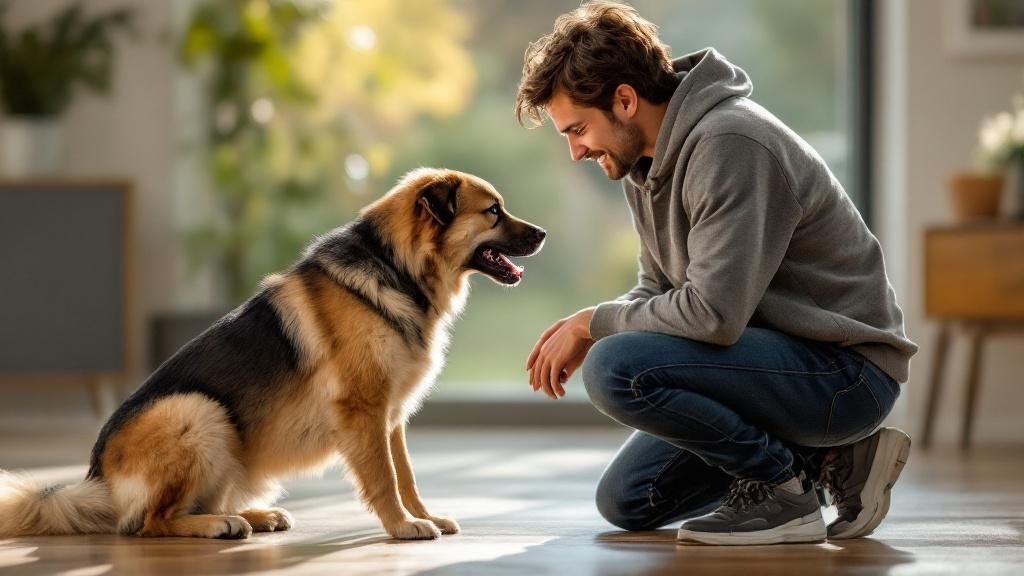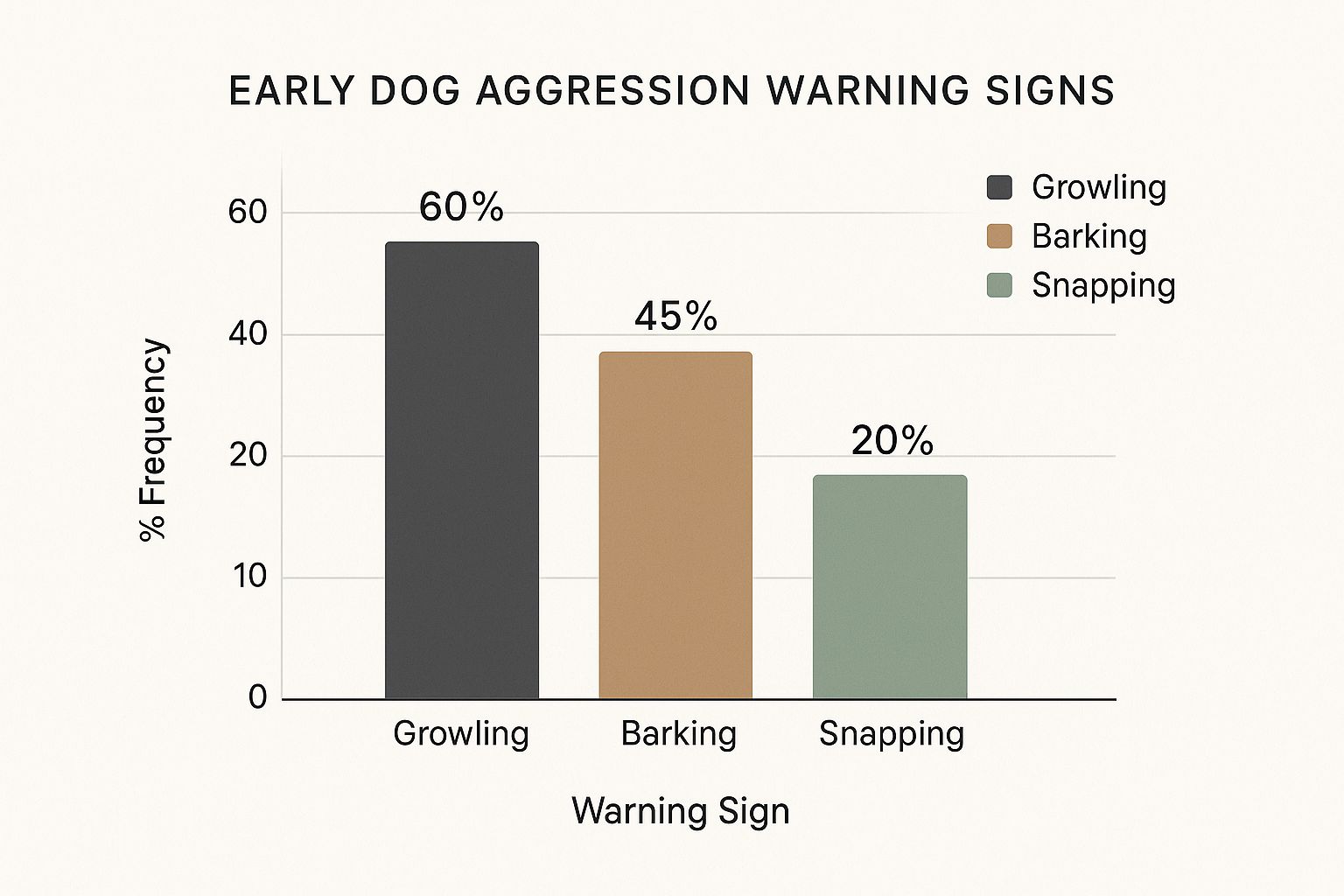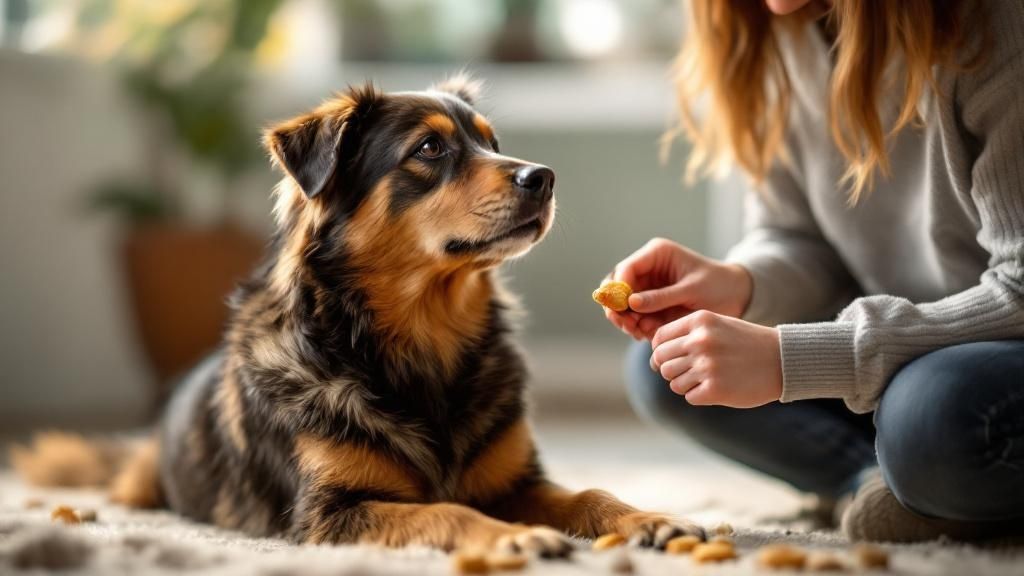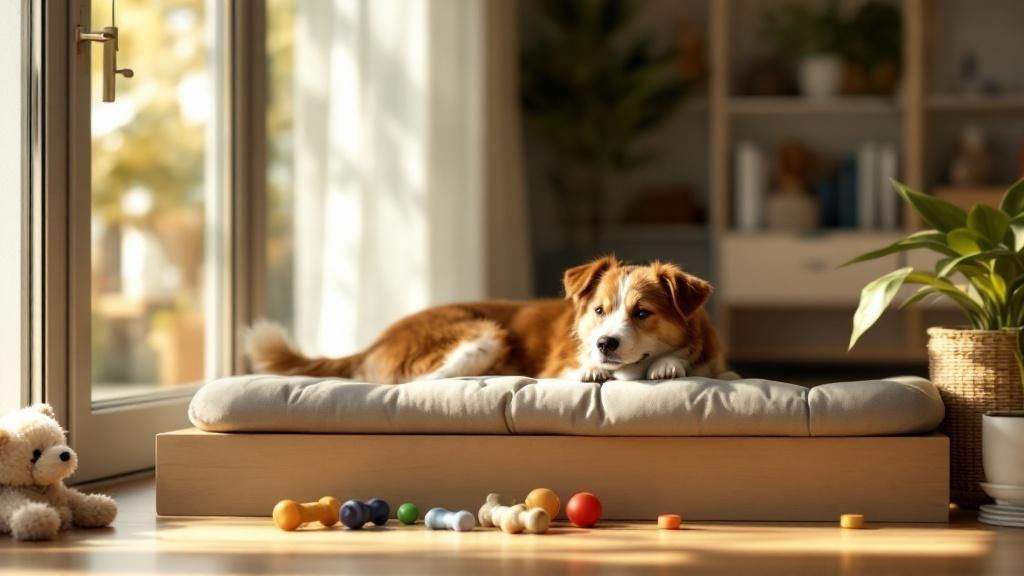When you're faced with dog aggression, we know your first thoughts are about safety and figuring out what's causing it. Let's start right there. Our first job is to secure the environment so another incident can't happen. It's also so important that we avoid punishing growls or other warnings. Instead, we'll calmly guide our dog away from whatever is triggering them. This is all about de-escalation, not correction.
Your First Steps with an Aggressive Dog
That moment your normally sweet dog growls, lunges, or snaps can be deeply unsettling. It’s a jarring experience that can leave you feeling shocked, isolated, and maybe even a little betrayed. Before you do anything else, please take a breath and hear this: you are not alone, and this does not mean you've failed as a dog owner.
Aggression isn't your dog being malicious; it's communication. Plain and simple. They're trying to tell you something important—often that they are scared, in pain, or completely overwhelmed by a situation. Our first job, together, is to listen and create safety for everyone involved.
This has become a particularly common struggle for many of us recently. In fact, dog aggression is a growing concern in the UK, with half of vets reporting a rise in clients worried about aggressive behaviour. This trend seems linked to the 'pandemic puppy boom', where many inexperienced owners brought dogs home without the usual opportunities for socialisation. You can read the full findings from the British Veterinary Association to get a better sense of the bigger picture.
Creating Immediate Safety
Right now, our primary goal is management, not training. We need to prevent the behaviour from being rehearsed. Think of it like putting up a safety barrier while we figure out what's really going on.
Here’s where we start:
- Become a detective and identify triggers. What was happening right before the incident? Was another dog getting too close? A stranger reaching over their head? Someone near their food bowl? Let's grab a notebook and start jotting down these patterns.
- Manage the environment like a pro. We can use tools like baby gates, crates, or even just closing doors to create distance from known triggers. If your dog is reactive to other dogs on walks, let's choose quieter routes or go out at less busy times of the day.
- Press pause and assess. For now, let's stop putting our dogs in situations where they feel the need to react aggressively. This isn't forever, but it's a crucial first step to lower their stress levels (and ours, too).
Shifting your mindset is absolutely key. Instead of seeing a "bad dog," try to see a dog who is having a really hard time. This compassionate perspective is the foundation for moving forward effectively and kindly.
Understanding Your Dog's Aggressive Behaviour
To really get to the bottom of aggressive behaviour, we first need to learn our dog's language. Aggression is almost always a symptom, a sign that something else is going on. Let's think of ourselves as detectives, piecing together clues to figure out what our dogs are trying to tell us. More often than not, it's a message rooted in fear, pain, or discomfort.
Once you start looking for patterns, you can begin to connect the dots between the behaviour and its emotional source. This shift in perspective is crucial. It allows us to move from simply reacting to scary incidents to proactively preventing them from happening in the first place. Understanding the ‘why’ is the absolute foundation for building any effective, humane plan to manage aggression.
Decoding Your Dog's Signals
Long before a dog growls, snaps, or bites, they're usually sending out much quieter signals that they're feeling uncomfortable. Learning to spot these subtle, early warnings is one of the most powerful things you can do. It's like learning to read the clouds before a storm rolls in.
Let's keep an eye out for these early indicators of stress or fear:
- A stiff, frozen body. Your dog might suddenly become very still, almost like a statue, as they try to process a potential threat.
- Whale eye. This is when you can see the whites of their eyes in a half-moon shape. It's a classic sign of anxiety, showing they're watching something warily out of the corner of their eye.
- Lip licking or excessive yawning. When it's not about food or being tired, these can be signs that your dog is feeling uneasy about the situation.
These small signals are your dog’s way of whispering, "I'm not comfortable with this." If we can listen and respond to these whispers, they won't feel the need to shout.
The chart below shows the warning signs owners most commonly recognise, but it's important to remember that the subtler cues often come first.
While growling is the most frequently reported warning at 60%, it's vital we see it for what it is: a crucial piece of communication, not an act of defiance. Your dog is telling you they've reached their limit.
Common Types of Dog Aggression and Their Triggers
Aggression isn't a one-size-fits-all behaviour; it has many different causes. To help you become that detective, we've broken down some of the most common forms of aggression. You might recognise some of these scenarios with your own dog.
| Type of Aggression | Common Triggers | Typical Behaviours |
|---|---|---|
| Territorial | Strangers or other dogs entering their home or garden. | Barking, lunging at windows/fences, growling. |
| Protective | A perceived threat to you or another family member. | Standing between you and the threat, growling, snapping. |
| Resource Guarding | Someone approaching their food, toys, bed, or even you. | Freezing, growling, snapping if the item is approached. |
| Fear-Based | Feeling cornered, loud noises, unfamiliar people or objects. | Cowering, trying to flee, but snapping or biting if escape isn't possible. |
| Pain-Induced | Being touched on a sore spot, anticipating pain (e.g., at the vet). | A sudden snap or growl when handled, often out of character. |
| Leash Reactivity | Seeing other dogs or people while on a lead. | Lunging, barking, and pulling on the lead, often from frustration or fear. |
Understanding which category your dog's behaviour falls into is a massive step towards finding the right solution. For instance, does your dog growl when someone approaches their food bowl? That's classic resource guarding, where they are trying to protect something they see as valuable.
Or perhaps your dog lunges and barks at strangers during your walks. This is often driven by fear or leash reactivity. They feel trapped by the lead and are trying to create distance to make the scary thing go away.
By identifying the specific context—what happens right before the growl or lunge—you can start to pinpoint the exact trigger. Is it a person wearing a hat? A specific dog? The sound of the hoover? Knowing the trigger is the key to helping your dog feel safe again.
Creating A Safe Management Plan At Home
Now that we have a better idea of the ‘why’ behind your dog’s behaviour, we can get stuck into the ‘how’. This is all about putting immediate, practical management in place to prevent any incidents and lower the stress levels for everyone in your home—including you.
Management isn’t a magic wand, and it’s certainly not about correcting your dog. Instead, let's think of it as creating a safe space where we can gently start to rebuild trust. The real goal is to set our dogs up for success by thoughtfully arranging their environment to avoid their known triggers.
It all comes down to proactively preventing the rehearsal of unwanted behaviours. Every time an aggressive reaction is triggered, your dog’s brain is flooded with stress hormones. By preventing these situations, we give their nervous system a chance to calm down, which creates a much better foundation for any future training.
Practical Strategies For A Calmer Home
Implementing a management plan doesn't mean you have to turn your house upside down. In our experience, it’s the small, consistent changes that make the biggest difference. You're essentially becoming the architect of your dog's environment, designing it for peace and predictability.
Here are a few simple but powerful strategies we can put into action today:
- Create Safe Zones with Baby Gates: Let's use gates to separate your dog from the front door when guests pop over, or just to give them a quiet space away from the general household chaos. This is such an easy way to manage territorial or fear-based reactions.
- Establish a "Hands-Off" Policy: If your dog guards high-value items like bones or specific toys, let's teach family members to give them space. A "trade up" game, where you offer an even better treat in exchange for the item, is a far safer and more productive approach than confrontation.
- Adjust Your Walking Routine: Is your dog reactive on the lead? Let's try walking at quieter times of the day, like early in the morning or late evening. Exploring different routes can also help you avoid those busy parks or streets that cause them stress. Proper lead handling is crucial, and a good refresher on essential leash training for dogs can make a world of difference.
Management is not about avoiding the problem; it's about giving your dog a break from their triggers. This mental rest is absolutely essential for any long-term behaviour modification to be successful.
Maintaining A Healthy Environment
A calm home environment goes beyond just physical barriers; it also includes the sensory details. Loud noises, strong smells from cleaning products, and general chaos can all add to a dog’s stress load.
As part of creating a truly calm space, let's make sure we're using safe, pet-friendly carpet cleaning methods and products. It might seem like a small detail, but minimising chemical irritants can really help your dog's overall well-being.
Remember, every small adjustment you make contributes to a more predictable and secure world for your dog. By managing their environment, you're not just preventing incidents—you're telling them, in a language they understand, that you've got their back and will keep them safe. This foundation of trust is everything.
Using Positive Methods to Modify Behaviour
Once you've got a solid management plan in place, we can start shifting our focus from just preventing incidents to actively changing how your dog feels about their triggers. This is where the real transformation begins. It's about moving beyond simply controlling the environment and starting to rewire your dog's emotional response, building their confidence rather than just managing their fear.
Think of yourself as your dog's teacher and biggest cheerleader on this journey. We’ll be using positive, science-backed methods to show them the world isn't as scary as they might think. The core idea is beautifully simple: we want to replace a negative feeling (like fear or anxiety) with a positive one (like calm, happy anticipation).
Changing The Emotional Response
The two most powerful tools we have for this are counter-conditioning and desensitisation. They might sound a bit technical, but the concepts are incredibly intuitive and form the bedrock of modern, humane dog training. We have a detailed guide on how to train a dog using these principles that goes into even more depth.
Here’s a breakdown of how they work together:
- Desensitisation: This is all about gradually exposing your dog to their trigger from a "sub-threshold" distance. That's a fancy way of saying a distance far enough away that they notice the trigger, but don't have a big, panicked reaction.
- Counter-conditioning: This is where the magic happens. While your dog sees their trigger at that safe distance, you give them something they absolutely love – proper high-value treats like chicken, cheese, or hot dog pieces.
Over time, your dog's brain literally starts to build a new association. The scary thing (another dog, for example) no longer predicts fear; it predicts that delicious chicken is about to appear. The emotional response gets rewired from "Oh no, danger!" to "Oh, goodie, that thing means treats are coming!"
This has become more crucial than ever in recent years. A survey from the Canine and Feline Behaviour Association pointed out that dog-on-dog aggression is on the rise in UK public spaces. Many of these incidents stem from a lack of control or poor recall, which just goes to show the growing need for better education on canine behaviour.
Putting It Into Practice
Let’s imagine your dog gets reactive towards other dogs when you're out for a walk. Here's how we'd apply these techniques in the real world.
First, you'd find a spot, maybe a quiet park bench, where you can see another dog from a massive distance—say, 50 metres or more. The instant your dog spots the other dog, and before they have a chance to react, you start feeding them tiny pieces of their favourite treat, one after another. When the other dog is out of sight, the treats stop completely.
You repeat this process over many different sessions, always, always keeping your dog under their reaction threshold. The moment you see any signs of stress—a stiff body, a hard stare, ears pricked forward—you know you're too close. That’s your cue to calmly create more distance and try again from further away next time.
This process is a marathon, not a sprint. We are asking our dogs to unlearn deeply ingrained emotional responses. You have to celebrate every small win—every calm glance at a trigger, every relaxed body posture—because each one is a huge step forward.
Eventually, you’ll be able to slowly, bit by bit, decrease the distance between your dog and their trigger, always pairing the sight of it with something wonderful. This approach empowers your dog to feel secure and in control, rather than threatened. It's about teaching them new coping skills and proving that you will always be there to keep them safe.
When to Find Professional Help
Trying to tackle dog aggression by yourself can be an incredibly lonely and overwhelming experience. We truly believe it's not something anyone should do alone. Deciding to bring in a professional isn't a sign you've failed; it's a brave and responsible act of love for your dog. It shows you’re committed to their well-being and ready to build a support team to help them feel safe and understood.
You’re not just hiring someone to "fix" a problem. You're partnering with an expert who can translate what your dog is trying to tell you. They can spot the subtle signs you might be missing and give you a clear, structured plan that takes the guesswork and anxiety out of the equation. This is absolutely critical in cases where the aggression is severe, unpredictable, or has already resulted in a bite.
Finding the Right Expert
The world of dog behaviour can be a bit of a minefield, with all sorts of different titles and qualifications thrown around. Figuring out who to call for your specific situation is the first, most important step. Not all professionals are created equal, and when it comes to aggression, you need specialist knowledge.
Here’s a quick rundown of the professionals you might come across:
- Dog Trainers: Great for teaching basic obedience cues like "sit," "stay," and good lead manners. However, most aren't equipped to handle complex behavioural issues like aggression.
- Certified Dog Behaviour Consultants (CDBC): These are the pros with specialised training and hands-on experience in serious behavioural problems, including aggression and anxiety. They focus on behaviour modification using humane, science-backed methods.
- Veterinary Behaviourists (VB): A VB is a fully qualified vet who has gone through extensive, additional training in animal behaviour. They can diagnose and treat behavioural issues, and crucially, they can also rule out underlying medical problems and prescribe medication if it's needed.
For any issues involving aggression, your best starting point is to look for a Certified Dog Behaviour Consultant or a Veterinary Behaviourist. You can get started by checking out our guide on finding a qualified dog behaviorist near me for tips on what to look for.
What to Look For and What to Avoid
When you're putting your dog's future in someone's hands, you want to be sure they’re the right fit. Look for certifications from respected UK bodies like the Association of Pet Behaviour Counsellors (APBC) or the Canine and Feline Behaviour Association (CFBA). These organisations require their members to have specific academic qualifications and stick to a strict ethical code.
Red Flag Alert: Be very wary of anyone who promises a "quick fix" or guarantees results. Behaviour modification is a gradual process that takes time and patience. Also, steer clear of any professional who advocates using punishment-based tools like prong collars, shock collars, or choke chains to deal with aggression. These methods only suppress the warning signs, like growling, and often make the underlying fear and anxiety much worse.
Your Questions About Dog Aggression Answered
Living with a dog who shows aggression brings up a whirlwind of questions and, let's be honest, some pretty deep-seated worries. It can feel like a lonely road, but we want you to know your concerns are completely valid and shared by so many dog owners out there. We've put together some of the most common questions we hear, with straightforward answers to help you find a path forward.
Can My Aggressive Dog Ever Be 'Cured'?
It’s far more helpful for us to think in terms of management and improvement rather than a magical "cure." Aggression often stems from powerful emotions like fear, and while we can't just erase those feelings, we can absolutely change how our dogs learn to respond to them.
Through consistent, positive training and a smart management plan, most dogs can learn to handle their triggers and live happy, safe lives. Our real goal is to lessen how often and how intensely they react, giving them better ways to cope. Every single calm moment you achieve together is a massive win.
Are Certain Breeds Just More Aggressive?
This is a stubborn myth that just won't go away. The simple truth is that aggression is down to the individual dog, not its breed. Yes, certain breeds were developed for specific jobs like guarding or herding, but any dog—from a Chihuahua to a Great Dane—can develop aggressive behaviours.
Things like poor socialisation when they were a puppy, hidden pain, a scary experience, or even their unique genetics play a much bigger role than breed. Judging a dog by its label doesn't work; it stops us from seeing the individual animal standing right in front of us.
Your dog's behaviour is telling you a story about their personal experience, health, and emotional state. The only way to truly help is to focus on the individual dog, not their breed label.
What Should I Do if My Dog Bites Someone?
First things first, you need to make the situation safe. Immediately secure your dog in another room or a crate to prevent anything else from happening. Your next priority is the person who was bitten. Help them with first aid and strongly urge them to get medical attention, as even small bites can get nasty infections.
Once the immediate crisis is over, you must contact a qualified professional without delay—think veterinary behaviourist or a certified dog behaviour consultant. A bite is a serious red flag, and you need an expert to help you figure out why it happened and to put a strict safety plan in place.
How Do I Handle My Own Stress and Fear?
Let us be clear: your feelings are completely normal and incredibly important. It's emotionally exhausting to live with a dog showing aggressive behaviour. And here's the kicker—your dog can pick up on your anxiety, which can make them even more nervous.
You have to look after yourself. Practise taking deep, calming breaths before and during walks. Make a conscious effort to notice and celebrate the small wins, no matter how tiny they seem. And please, don't be afraid to find support for yourself, whether it's talking to an understanding friend, joining a support group for owners in similar situations, or even speaking with a therapist. Looking after your own well-being is a huge part of looking after your dog.
Here at K9 Time, we get that managing your dog's needs is a big ask, especially when you're working through behavioural challenges. We offer one-to-one dog walking services right here in Sheffield, giving your dog the calm, structured, and safe exercise they need to thrive. Find out more at https://k9time.co.uk.






